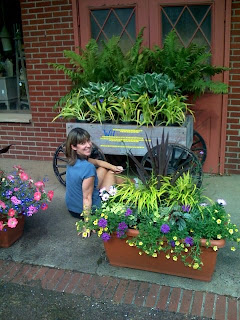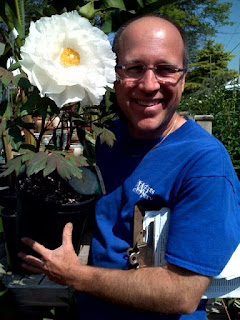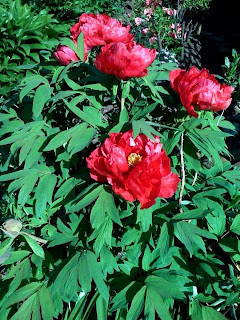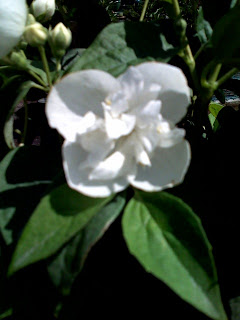I had all intentions of putting this list in yesterdays post, but I got sidetracked with my story.
Here is a list of some of the eggplant, pepper, and tomato varieties that we now have in stock (some are limited, so it's possible that all varities won't be available at all times):
• EGGPLANT Black Beauty- bushy, spreading plant, bearing dark purple almost black fruit
weighing 1-3 lbs each. Good flavor and retains color well. ‘Standard eggplant”
• EGGPLANT Classic – Oval, elongated 8-9 in fruit
•EGGPLANT Fairy Tale – AASAward Winner! DWARF plants produce miniature fruit that is bicolor
lavender and white.
• EGGPLANT Ghostbuster – white fruit that are sweeter than purple types.
• EGGPLANT Ichiban- a prolific variety bearing cylindrical fruit with shiny, blackish, purple skin.
• EGGPLANT Little Fingers- an abundance of slim, long, dark purple, 6-8in. Fruit grows three
to six per cluster. Spineless plants make picking easy. BEST variety in our Grower’s opinion.
• EGGPLANT Turkish Orange -Miniature orange-red fruits, look like tomatoes. The tall (4')
plants are spineless and are very attractive when laden with fruit
• EGGPLANT Snowy F1- ivory white, 6-8” fruits. Sweet yet mild flavor.
• PEPPER Bell Boy - Large four-lobed fruit with thick walls. Matures green to red.
• PEPPER Better Belle – Very blocky, four-lobed fruit. Matures green to red
• PEPPER Blushing Beauty - matures from ivory to blush to red, then orange-red and finally
darker red. Thick walled and sweet tasting.
• PEPPER California Wonder- Blocky, 4 in., good for stuffing, Green to red.
• PEPPER Carmen-(Award Winner!) Horn shaped fruit with wide shoulders and tapered
shape. Super sweet flavor, compact grower, red to green color, and prolific producer.
• PEPPER Chocolate Beauty - matures to rich mahogany
• PEPPER Giant Marconi – tapered green pepper will mature to red, has a sweet smoky
flavor
• PEPPER Golden Summer – Ripens to a bright golden yellow
• PEPPER Gypsy – sweet pepper matures from yellow to red, wedge shaped fruit
• PEPPER Holy Mole-(Award Winner!) Long tapering shape, 7-9 inches long and a beautiful
purple to black color. A Pasillia pepper perfect for traditional Mexican cuisine, mildly hot with a
nutty tangy flavor. Compact plants that are profuse fruiters.
• PEPPER Hungarian Wax- early & productive, medium thick walls, bright yellow to red
• PEPPER Italian Fryer Cubanelle - Ripens from yellow-green to orange-red.
• PEPPER Jalapeno- Compact plant, high yield. Matures from green to red.
• PEPPER Key Largo F1 - Early, mild / sweet flavor, >Cubanelle= type. Matures from yellow
/green to orange/ red.
• PEPPER Lilac – beautiful lilac-lavender color. 3-4 lobed fruits mature ivory to lavender to
red.
• PEPPER Mandarin - deep pumpkin-orange color on elongated, European-style fruits. 5-6"
long, smooth and firm. Sweet flavor.
• PEPPER Mariachi – Spicy, but only mildly hot. Creamy yellow to bright red.
• PEPPER Pepperoncini- perfect for pickled Italian green peppers. Imported directly from
Milan, yields abundant yellow-green, 2-4" sweet-spicy fruits.
• PEPPER Purple Beauty - deep purple bells with thick walls, compact
• PEPPER Red Beauty – Ripens more red peppers earlier
• PEPPER Red Large Cherry – ripens from medium green to red
• PEPPER Serrano- 1.5 in.-2 in. peppers are among the top 10 hottest now on the market.
Bright green to red.
• PEPPER Spanish Spice- Thin walled, gourmet fruit is slightly tapered. Tobacco Mosaic
resistant. Green to red.
• PEPPER Super Cayenne F1 - Highly productive and very hot.
• PEPPER Sweet Banana- have medium to thick walls. Yellow to red.
• PEPPER Sweet Rainbow Mix - Colors include red, orange, yellow, chocolate, lilac, ivory,
green and purple.
• PEPPER Thai Hot Dragon - five times hotter than a standard jalapeno. Prolific, high-yielding
plants. Thin walls that dry easily.
• TOMATO Better Boy - extra large >Beefmaster= type, (16 oz). Indeterminate. Alternaria and
Stenophylium resistant. VFN. Nice Full pots.
• TOMATO ‘BIG BOY’- Vigorous plants produce 16 oz. fruit. Indeterminate. Full pots.
• TOMATO Black Krim – dark brown, red tomatoes, very richly flavored with a hint of saltiness.
• TOMATO Brandywine – Heirloom variety beefsteak type, deep pink skin with red flesh
• TOMATO Bush Champion – compact plants great for small spaces, with 8-12 oz fruit
• TOMATO Cherokee Purple – extremely productive and has a very rich tomato flavor
• TOMATO Early Girl - extremely early, 4-6 oz tomatoes. Indeterminate. VF1+2
• TOMATO Golden Girl - large 7-8 oz smooth golden yellow fruit
• TOMATO Health Kick - Small fruit contains extra lycopene which is known to fight some
types of cancer. Determinate. Full Pots. VF also resists Alternaria, Stem Canker, Leaf Spot,
Tomato Spotted Wilt. WOW!
• TOMATO Jet Star – 6-8 oz fruit have great color.
• TOMATO Juliet – grows in grape-like clusters on a long vigorous vine. Elongated cherry type.
• TOMATO Keepsake – medium size fruits
• TOMATO Lemon Boy – 7 oz tomatoes feature lemon yellow skin
• TOMATO Mini Charm - tall, indeterminate plants produce oval, 9 oz grape-like fruit.
• TOMATO Mortgage Lifter – heirloom variety. Meaty full of flavor
• TOMATO Mr. Stripey – a yellow beefsteak type of fruit with red streaked flesh
• TOMATO Roma Plum – bright red, 2 oz plum-shaped fruit
• TOMATO Rutgers - produce 5-6 oz. fruit. Excellent all purpose variety. Very productive and
disease resistant. “The basic red tomato” Full pots. VF Determinate.
• TOMATO San Marzano – for canning, paste and spaghetti sauce, low in sugar and acid
• TOMATO Sugary – ½ oz cherry tomato fruit is very sweet. Pinkish red color
• TOMATO Sun Sugar – golden cherry tomato with a very sweet taste
• TOMATO Sweet Olive – sweet, bite-sized, bright red grape tomatoes. Strong tolerance to
heat
• TOMATO Tomande – ribbed 6-7 oz fruit, sweet grows compact old world appearance
• TOMATO Tomatillo Toma Verde – tennis ball-sized with a papery husk. Full-bodied flavor is
sweet, yet spicy
• TOMATO Viva Italia – earlier and more productive, with higher quality blocky fruits
• TOMATO Whopper – Heavy producer, medium sized fruits, early. Great tasting.
Nice and full pots. Indeterminate.
• TOMATO Yellow Pear – heirloom variety small pear-shaped yellow fruit .
 Well, after I got the results of our favorite annual poll I was extremely surprised. (well more like astonished) that the Gazania did not receive a single vote.
Well, after I got the results of our favorite annual poll I was extremely surprised. (well more like astonished) that the Gazania did not receive a single vote. Once they become established they tend to be very drought tolerant. They want full hot sun. They are very short growing reaching only 6 to eight inches. If you let them dry out, they won't be angry and leave the garden. They'll just keep flowering. The colors are absolutely stunning. They can range from the brightest orange to yellow to shades of pink. Many of the varieties have distinctive dark color bands.
Once they become established they tend to be very drought tolerant. They want full hot sun. They are very short growing reaching only 6 to eight inches. If you let them dry out, they won't be angry and leave the garden. They'll just keep flowering. The colors are absolutely stunning. They can range from the brightest orange to yellow to shades of pink. Many of the varieties have distinctive dark color bands.












